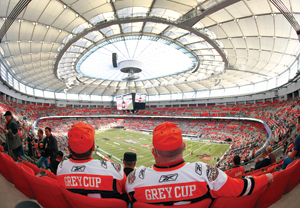The Super Bowl is the undisputed single-day champion of annual sports television ratings in North America. With a worldwide TV audience of more than 150 million and network advertising revenue approaching $4 million per 30-second spot, it’s an American event of unparalleled proportions.
But what if we asked you to name North America’s top five? Would you guess the World Series? The NBA All-Star Game? The Indy 500? What about the NFL’s conference championship games?
While it’s not quite a clear-cut answer (based on teams involved, date or year), we’re comfortable framing an argument that one of the right answers is an annual football game staged north of the U.S. border by the Canadian Football League. We know that because in 2011, the CFL’s Grey Cup continued its decade-long rise as a Super Bowl-esque event that comes close to stopping a nation. To wit, this Cup (and not Lord Stanley’s) is widely known for drawing avid fans from across an entire country to a weeklong, citywide celebration.
With the CFL’s TV audience peaking, according to BBM Canada, at 14 million Canadians for the TSN (English) and RDS (French) broadcasts, and sponsorship support growing (reportedly up 16 percent for 2011), including investments from brands like Nissan, Molson Canada and Scotiabank, the Grey Cup’s performance is quite comparable to the NFL’s conference championship games. Even better, the Grey Cup’s total reach via TV was about 42 percent of Canada’s 34 million population, and penetration numbers like that suggest that the Cup in Canada is similar to the Super Bowl’s relevance in the U.S.
 |
The three-day festival before the 2011 Grey Cup had a $118M economic impact on Vancouver.
Photo by: GETTY IMAGES
|
“It’s not a particularly favorable economy right now, but the Argonauts have done quite well with our partnership revenue numbers,” said Dave Bedford, who is leading the sales and marketing for the Toronto Argonauts’ management of the 2012 Grey Cup Festival, the historic 100th. “As of Oct. 10, we had 41 sponsors, a multistation television and radio partnership, and two major daily newspaper partnerships. We’re ahead of plan in terms of cash, budget-relieving VIK [value-in-kind or contra sponsorship] and non-budget-relieving targets. We’re also significantly ahead of any previous Grey Cup Festivals … which really isn’t a surprise given the significance of the Grey Cup centennial and the fact it’s taking place in Canada’s biggest market.”
Bedford went on to describe the vast cityscape of celebrations happening around Toronto by noting, “What’s really interesting about these Grey Cup activations is that we have four specific zones of activity that are all demographically based or linked to specific target markets such as family, teens, partiers, football fans and others.”
Each zone carries the name of a sponsor — for example Nissan, MBNA, Telus and Scotiabank — and is located in downtown Toronto at familiar locations such as Yonge-Dundas Square, Nathan Phillips Square/City Hall and the Metro Toronto Convention Centre. At the MBNA Adrenaline Zone for young adults, the Toronto Sun will even go so far as to present the world’s longest urban zip line.
Strangely, though, most American sports marketers rarely know when or where the Grey Cup is held and may not know if their brand should start thinking about the value of this event in order to leverage Canadian activation opportunities. Perhaps the CFL needs to up its marketing efforts south of the border in places like Buffalo, Detroit, Cleveland, Columbus and Syracuse, where football fans are many and sport marketers are among the most sophisticated in the world.
For starters, the Grey Cup is thought to have created about $118 million of economic impact in Vancouver for 2011’s three-day festival. That $100 million-plus would approach the NBA’s All-Star Game this past February in Orlando, which reportedly brought in about 50,000 out-of-town visitors, booked more than 25,000 room nights and attracted more than 1,000 media members (many of them from foreign countries).
Further, the Grey Cup gives Canadians something the NHL can’t: an eight-team league filled only with Canadian teams (not to mention a league that isn’t locked out). Given that the NHL has canceled all November games, this 100th Cup should attract an even larger audience and raises the question of whether NHL sponsors were looking for the right contingency alternatives a year ago.
So, in case you’re wondering: This year’s Cup will take place at the Rogers Centre in Toronto on Nov. 25, but the festival itself will cover nine days (beginning Saturday and running through game day), and CFL Commissioner Mark Cohon thinks this year could be a breakthrough year. Given the tribal relationship between fans and football, it should be.
“Nothing brings Canadians together quite like the Grey Cup,” Cohon said. “The festival revolves around the game, but the game has evolved into a celebration of our league, our country and the bond between them.”
That sounds like an executive who knows his regional/national brand now acts very much like a global property. What a shame that some American sports marketers don’t realize what’s happening less than 100 miles from their border.
Rick Burton (rhburton@syr.edu) is the David B. Falk Professor of Sport Management at Syracuse University. Norm O’Reilly (norman.oreilly@uottawa.ca) is an associate professor of sport business at University of Ottawa.





